

Home |
About BDB |
The Long Road |
Afternoon |
Review Archive |
Recordings |
Photos/EPK |
Contact |
BassDrumBone-Review Archive

BassDrumBone
at 1st at 1st, NYC (preview
article)
BassDrumBone is
not a typical melody and rhythm section lineup. Mr. Hemingway is uncommonly
alert to the tones and timbres of his drums and percussion instruments; Mr.
Anderson can make rip-snorting "tailgate" trombone sounds as well
as well-turned melodies. And Mr. Hellas can work between or around or against
whatever melodies and noises the other two toss off. "We do a lot of open
improvisations within the structure of the tunes, or without the structure Of
the tunes," Mr. Hellas said. "There, are pieces that function as song,
forms and other things that function sort of as improvisational chamber music.
But there's always a space to open up and play."
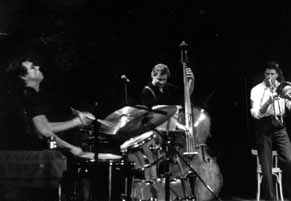 "There's this visual, and in
some way audio conception that the trombone is out front, it being the most
,traditional melodic instrument," Mr. Anderson said. "But if you listen
for a minute, you hear that all the parts are equal and all the musical roles
are interchangeable. When I'm playing, I'm not always taking a solo might be
nudging Helias along or playing something directly opposite to what he's doing.
After 10 years, It's really got a unique kind of rapport. We can change directions
as fast as we want to, and the trio will always land on its feet."
"There's this visual, and in
some way audio conception that the trombone is out front, it being the most
,traditional melodic instrument," Mr. Anderson said. "But if you listen
for a minute, you hear that all the parts are equal and all the musical roles
are interchangeable. When I'm playing, I'm not always taking a solo might be
nudging Helias along or playing something directly opposite to what he's doing.
After 10 years, It's really got a unique kind of rapport. We can change directions
as fast as we want to, and the trio will always land on its feet."
Mr. Anderson also
has a good term for BassDrumBone's music. It's fun," he said
Jon Parales Friday March 27, 1987
THE NEW YORK TIMES
BassDrumBone
BASSDRUMBONE - the trio of Mark Helias on bass, Gerry Hemingway on drums and Ray Anderson on trombone romps through it's music, artfully pulling compositions in three directions at once. Like the trio Air and a very few other jazz ensembles, BassDrumBone's collective improvisations can be bluesy or ethereal, pensive or raucous in the space of a few seconds. In the early -set Thursday at Sweet Basil, the compositions touched on free-bop, calypso, blues and a ballad, but they were volatile the players would easily shift into double time, toss around cross-rhythms or fall into a hush as if on a single impulse.
Mr. Anderson has all the technique a trombonist could ask for. He can reel off fast, exact chromatic lines; he can growl and snort and yowl, tailgate-style he can create doublestops by singing harmony as he plays. He and Mr. Helias make the trio's melodic statements, sharing a burnished low register or jumping octaves apart. But all three players leap into the territory between melody and rhythm, setting up a crossfire of textures and sliding notes; Mr. Hemingway weighs the timbre, as well as the rhythm, of every drumbeat or cymbal tap. Together, they make new jazz that's as warm-hearted as it is intelligent.
Jon Pareles Sunday, January 25,1987
 -
May 1979
-
May 1979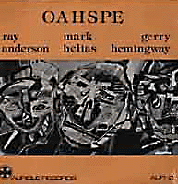 RAY ANDERSON is a tough trombonist as presented
on GERRY HEMINGWAY'S (vbs, dr) second AURICLE release, "OAHSPE" (AUR-2),
completing the trio.. for the Nov. 22 and 25, 1978 cooperative recording is
bassist MARK HELIAS. Of Mr. Hemingway and friends' first Auricle release (Nov.
78, p. 34) Carl Brauer wrote that the music could have been more strongly focused
but that this was a group (0ahspe). to watch: well based on this second recording,
this is still a group to watch, but musically they have arrived for this is
a most appealing, satisfying and stimulating 42:13 minutes of music (five originals
by group members: Gyro, Albert, Beef, Sextant, Gibberish) . The lead voice here
is Anderson an inventive muscular trombonist who plays with conviction, humor,
irony and what could best be described as a tailgate body language. Hemingway's
drumming (his main role here) both in counterpoint or mimmicking support to
Anderson's work, is always in close proximity to the trombone exploration and
gives a sense of lyricism to the music. Helias' bass, falling more traditionally
between the two, works as a spring, absorbing and pushing away throughout a
challenging trip.
RAY ANDERSON is a tough trombonist as presented
on GERRY HEMINGWAY'S (vbs, dr) second AURICLE release, "OAHSPE" (AUR-2),
completing the trio.. for the Nov. 22 and 25, 1978 cooperative recording is
bassist MARK HELIAS. Of Mr. Hemingway and friends' first Auricle release (Nov.
78, p. 34) Carl Brauer wrote that the music could have been more strongly focused
but that this was a group (0ahspe). to watch: well based on this second recording,
this is still a group to watch, but musically they have arrived for this is
a most appealing, satisfying and stimulating 42:13 minutes of music (five originals
by group members: Gyro, Albert, Beef, Sextant, Gibberish) . The lead voice here
is Anderson an inventive muscular trombonist who plays with conviction, humor,
irony and what could best be described as a tailgate body language. Hemingway's
drumming (his main role here) both in counterpoint or mimmicking support to
Anderson's work, is always in close proximity to the trombone exploration and
gives a sense of lyricism to the music. Helias' bass, falling more traditionally
between the two, works as a spring, absorbing and pushing away throughout a
challenging trip.
The group's closeness
can be seen in the music which while composed by three different individuals
has a similar attack or attitude. The music is consistently graphic and reminds
me of tent show music and has a similar feel to the trombone work and rhythms
found in Mingus' "Clown". It all has great agility and is very full
(complete) . The only strong break in texture is the brief use of vibes, which
by its very nature adds a more impressionistic or pastel quality to the music.
If you're a fan of trombone, or perhaps I should say if you're not a fan of
the trombone listen to this record. Exceptionally good music, fearlessly played
and tightly coordinated. Recommended.
Bob Rusch
Downbeat- VOLUME 46, NO. 16 Oahspe (Auricle Aur-2):
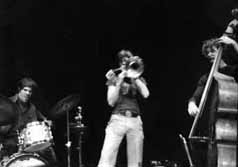 No one could accuse Oahspe (Ray Anderson, trombone
Mark Helias, bass; Gerry Hemingway, drums) of rambling discursive playing and
when Anderson lets loose, the music is absolutely volcanic. These young turks
have played, together and separately, with a number of sterling musicians including
Dewey Redman, Anthony Davis, Braxton, George Lewis, Sam Rivers and Barry Altschul,
and all three previously appeared on Hemingway's first Auricle album Kwambe,
though in more crowded surroundings. Here, trimmed to a trio, the group sound;
less self-consciously diverse and more compatible, taking advantage of a number
of flexible ensemble contrapuntal devices and solo situations Hemingway is a
sympathetic accompanist and Helias is a supportive rock throughout but Anderson
is the main voice. Taking Rudd and Mangelsdorf as a jumping-off for lyrical
legato melismas and fiery explosions which can erupt blisters on your skin,
this trombomist is a musician to reckon with right now. Especially noteworthy
on this consistently engaging release is the gutsy paean to Albert Ayler- though
not incorporating any of his unique free stylings and Beef, which adds timbral
variety via Hemingway's melodic vibraphone and Anderson sons outrageous tailgaiting.
Highly recommended. Art Lange-October 1979
(**** 4 1/2 stars)
No one could accuse Oahspe (Ray Anderson, trombone
Mark Helias, bass; Gerry Hemingway, drums) of rambling discursive playing and
when Anderson lets loose, the music is absolutely volcanic. These young turks
have played, together and separately, with a number of sterling musicians including
Dewey Redman, Anthony Davis, Braxton, George Lewis, Sam Rivers and Barry Altschul,
and all three previously appeared on Hemingway's first Auricle album Kwambe,
though in more crowded surroundings. Here, trimmed to a trio, the group sound;
less self-consciously diverse and more compatible, taking advantage of a number
of flexible ensemble contrapuntal devices and solo situations Hemingway is a
sympathetic accompanist and Helias is a supportive rock throughout but Anderson
is the main voice. Taking Rudd and Mangelsdorf as a jumping-off for lyrical
legato melismas and fiery explosions which can erupt blisters on your skin,
this trombomist is a musician to reckon with right now. Especially noteworthy
on this consistently engaging release is the gutsy paean to Albert Ayler- though
not incorporating any of his unique free stylings and Beef, which adds timbral
variety via Hemingway's melodic vibraphone and Anderson sons outrageous tailgaiting.
Highly recommended. Art Lange-October 1979
(**** 4 1/2 stars)
 BassDrumBone
trio, live and on You Be (Minor Music), performs with an equilateral strength
and intuitive communion reminiscent of the trio Air.
BassDrumBone
trio, live and on You Be (Minor Music), performs with an equilateral strength
and intuitive communion reminiscent of the trio Air.
"Music Is an Open Sky" Village Voice, March 1987- Howard Mandel
Jazz Journal International
YOU
BE
(Minor Music 007)
Question Mark, You Be; Pumbum, Boxcars (24.01), Stole Stroll; Edward's Dance;
Mudpie Anthem (24.04)
Ray Anderson (tbn) , Mark Helias (b); Gerry Hemingway (d). Ludwigsburg, November
1985.
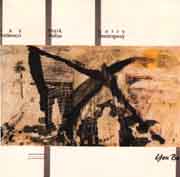 This
uplifting recording should be obligatory listening for anyone who doubts the
communicative, swinging warmth of the best of post-Coleman jazz today, or any
avant garde classical enthusiast who wonders why contemporary jazz fans don't
always rush to hear the latest computer-generated piece for light bulb and trombone.
This technically excellent historically sophisticated trio open with a solid
swinger straight out of the Blue Note book, Anderson's fruitily toned, boisterously
humorous ideas flowing out of the rich triplet figures which Hemingway rolls
around Helias deft switches from pedal points to big, walking lines. You Be's
reflective arco meditations induce some wonderfully relaxed, variegated musings
from Anderson, sliding all over the horn with a tone now pure now deliciously
burred, intimating a capacity for the sort of exquisitely delicate dynamics
realised on Mudpie Anthem. After such compelling cuts, the listener is ready
for anything and everything, and gets a fair slice of both as these superbly
alert players romp through formidable bop phrases as they invigorate old time
shuffle' (Stole Stroll) or calypso humour (Edward's Dance). Boxcars offers a
brooding, impressionistic journey into the depths of abstraction, completing
the sense of wide-open, searching intelligence present in every other number.
This
uplifting recording should be obligatory listening for anyone who doubts the
communicative, swinging warmth of the best of post-Coleman jazz today, or any
avant garde classical enthusiast who wonders why contemporary jazz fans don't
always rush to hear the latest computer-generated piece for light bulb and trombone.
This technically excellent historically sophisticated trio open with a solid
swinger straight out of the Blue Note book, Anderson's fruitily toned, boisterously
humorous ideas flowing out of the rich triplet figures which Hemingway rolls
around Helias deft switches from pedal points to big, walking lines. You Be's
reflective arco meditations induce some wonderfully relaxed, variegated musings
from Anderson, sliding all over the horn with a tone now pure now deliciously
burred, intimating a capacity for the sort of exquisitely delicate dynamics
realised on Mudpie Anthem. After such compelling cuts, the listener is ready
for anything and everything, and gets a fair slice of both as these superbly
alert players romp through formidable bop phrases as they invigorate old time
shuffle' (Stole Stroll) or calypso humour (Edward's Dance). Boxcars offers a
brooding, impressionistic journey into the depths of abstraction, completing
the sense of wide-open, searching intelligence present in every other number.
There is a lot of talk about postmodernism in the arts now, as our increasingly fragmented culture realises the enervating consequences of facile notions of progress. This recording seems as good a document as any of the enriching potentialities of such a reappraisal, and I'm sure that that great Post-modernist of jazz, Charles Mingus, would have loved it. Michael Tucker-September 1986
 One
little known fact about the
You Be session is that the producer,
Stephan Meyner overlooked the fact that I do not travel with my drums, and so
when we arrived at the hallowed Ludwigsberg studio I was obliged to put my creative
talents to new uses, creating a drum set out of spare instruments I found in
storage closets in the building. The resulting drum set (to your right) had
a few notable features including toilet paper wrapped around a mike stand and
jimmied to the mounted tom-tom hardware. Somehow I made it work, one would never
know what I was contending with for an instrument by listening to the record.
G.H.
One
little known fact about the
You Be session is that the producer,
Stephan Meyner overlooked the fact that I do not travel with my drums, and so
when we arrived at the hallowed Ludwigsberg studio I was obliged to put my creative
talents to new uses, creating a drum set out of spare instruments I found in
storage closets in the building. The resulting drum set (to your right) had
a few notable features including toilet paper wrapped around a mike stand and
jimmied to the mounted tom-tom hardware. Somehow I made it work, one would never
know what I was contending with for an instrument by listening to the record.
G.H.
 You
Be finds
Anderson back in the 'new music camp on a stunningly effective program of original
pieces. Frequent collaborators bassist Helias and drummer Hemingway are on equal
footing with the trombonist: each trio member contributes compositions and no
single instrumental voice dominates. Anderson's title piece pivots on a delightful
bass line that trombone and drums either nudge or blandish, and his Stole Stroll
achieves its agitated mood through reciprocal action. Edward's Dance, a suite
designed by Hemingway in homage to free drumming pioneer Ed Blackwell, has the
musicians riding an emotional roller-coaster; Hemingway, as would Blackwell,
keeps fluid time and avoids clutter Helias Boxcars is somewhat diffuse despite
the players'uncanny interaction while, on the other hand, the bassist's Mudpie
Anthem is musically and emotionally direct in its evocation of tender sorrow.
A second excellent record.
You
Be finds
Anderson back in the 'new music camp on a stunningly effective program of original
pieces. Frequent collaborators bassist Helias and drummer Hemingway are on equal
footing with the trombonist: each trio member contributes compositions and no
single instrumental voice dominates. Anderson's title piece pivots on a delightful
bass line that trombone and drums either nudge or blandish, and his Stole Stroll
achieves its agitated mood through reciprocal action. Edward's Dance, a suite
designed by Hemingway in homage to free drumming pioneer Ed Blackwell, has the
musicians riding an emotional roller-coaster; Hemingway, as would Blackwell,
keeps fluid time and avoids clutter Helias Boxcars is somewhat diffuse despite
the players'uncanny interaction while, on the other hand, the bassist's Mudpie
Anthem is musically and emotionally direct in its evocation of tender sorrow.
A second excellent record.
Frank-John Hadley-January 1987 (**** four
stars)
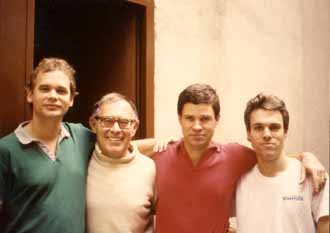
Jazz Times
BassDrum Bone- Hence the Reason - ENJA ENJ-9322 2 (64:39)
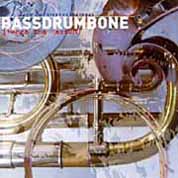 BassDrumBone
is the synergetic threesome of bassist Mark Helias, drummer Gerry Hemingway
and trombonist Ray Anderson. Three inspired savants, the trio turns the inside
out and the outside in. One might call the energized results "postmodern"
in that what typically unfolds is a stylistic pastiche embracing everything
from New Orleans traditional to the Harmelodics of Ornette Coleman.
BassDrumBone
is the synergetic threesome of bassist Mark Helias, drummer Gerry Hemingway
and trombonist Ray Anderson. Three inspired savants, the trio turns the inside
out and the outside in. One might call the energized results "postmodern"
in that what typically unfolds is a stylistic pastiche embracing everything
from New Orleans traditional to the Harmelodics of Ornette Coleman.
As to the former check out "Hence Real Reason" where at moments Anderson's slippery slides and Hemingway's street beat abstractions evoke a mind-bending "X Files" Crescent City spatio-temporal warp. As for the latter, there's "For Don C" in which the trio's open-ended strolling recalls the ramblin' of pocket-trumpeter Cherry. Equally impressive is Fictionary," a stop-start, rubatoesque drama constructed from carefully modulated group dynamics and Anderson's bravura intervallic leaps. What's amazing is how warm and appealing and yet excitingly odd these tracks are. Like sound-seekers Ornette Coleman and Bill Frisell BassDrumBone while estranging the familiar also accentuates the positive.
Chuck Berg, JAZZTIMES, February 1998
The Line Up was recorded in April of 2005 and released on Clean Feed Records of Portugal in late October/early November of 2006. You can hear examples of it here. Review from Tom Sekowski. Review from AllAboutJazz - Troy Collins.

Touching Extremes (Massimo Ricci) review of the the Line Up...
The liners define BassDrumBone a "super team" and it's difficult proving the contrary, as Mark Helias (double bass & bass guitar), Gerry Hemingway (drums) and Ray Anderson (trombone) are three of the finest jazz musicians on the scene, their collaboration dating back from about 30 years ago. "The line up" comprises nine tracks that leave no time to back up from the flurries and combinations that these gentlemen bring to our ears. The most visible voice is naturally Anderson's, his trombone gauging the need of liberating jazz from the chains of irrelevance through a kind of phrasing that converges towards tonal centres and immediately flies away while remaining totally independent from poor-spirited gestural uselessness, his tone instead both effervescent and placatory. Helias is one of those bassists that play the line like the air would like to hear it, propelling the contrapuntal activities into the realms of field-day improvisation while remaining lyrically conscious at all times. Hemingway is the symbolic incarnation of the war that should be declared against the feeble-minded swingers who cause the idiots' heads in the clubs to cluelessly bounce up and down with their glass in hand; his playing is spectacular at times, fractured at the right moments, always able to shift the balance of the trio within the space of half a beat. An electrifying effort that captures at the first listening.
All About Jazz review of the Line Up....from Glenn Astarita:
Celebrating thirty-years as a trio project, this unit of estimable modern jazz artists has recorded for the Italian Soul Note record label and others since its inception in 1977. It's a veritable jazz super-group. Ray Anderson’s pumping trombone lines steer the way for a cavalcade of movements, consisting of tricky maneuvers and some hyper-mode frazzle and dazzle. And it’s easy to discern why the group’s lasted as long as it has: factor in the musicians' strikingly intuitive sensibilities, where strategies are re-engineered and refreshed in dynamic fashion. They successfully mingle very diverse elements into their overall game-plan. Bassist Mark Helias and drummer Gerry Hemingway engage in brisk rhythmic structures, and the unit enjoys ample soloing spots to counterbalance a foray of interloping exchanges. Think of a precision-machine with loose groove formats and a horde of improvisation-based retooling processes.
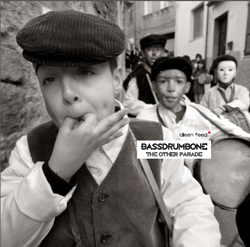
The Other Parade was released on May 6, 2011 on Clean Feed Records. It was recorded in August 2009 in NYC and features nine new compositions commissioned by Chamber Music America's "New Works" Program on the occasion of our 30th anniversary. It is avaiiable from this site here, and you can hear examples of it here.
"Needless to emphasize that the disc is packed with stunning solos, how to highlight a telepathic interplay, how infectious the music flow, how to be able to satisfy the most refined palates as the occasional listener and less jaded. The beautiful cover photo speaks of centuries-old traditions - portrays the young drummers of Gavoi (town in the heart of Barbagia) during the carnival - the music contained on The Other Parade is steeped in tradition, but speaks the language of modernity." Vincenzo Roggero AAJ Italia
The story keeps unfolding for this fabled trio that released its first outing in 1978. With rest stops along the way, the musicians' synergy remains as a source of amazement, coupled with their perpetual creative sparks that sculpt a route embedded with fresh concepts and supreme musicianship. BassDrumBone pursues steamy New Orleans funk, vast modes of expressionism, and cunning improvisational dialogues. The artists whirl through linear unison lines and abide by an open-air musical forum via persuasive theme constructions. Variety is a predominant factor here. Yet they close the album on a simple and rather somber note during the title piece, "The Other Parade." Here, trombonist Ray Anderson's blustery notes and soul-searching lyricism is underscored with vocal attributes atop drummer Gerry Hemingway's punctuating backbeats and bassist Mark Helias' firm bottom-end. It's a dirge-like motif, where the band gradually raises the pitch to instill an impression of spiritual reckoning.
The title piece is relatively simple by design, yet the musicians' sentiment generates elements of joy and angst. With yearning lines and a penetrating mode of attack, the trio consummates this wondrous outing by soothing the program with heartfelt realism and striking imagery. Glenn Astarita JazzReview.com